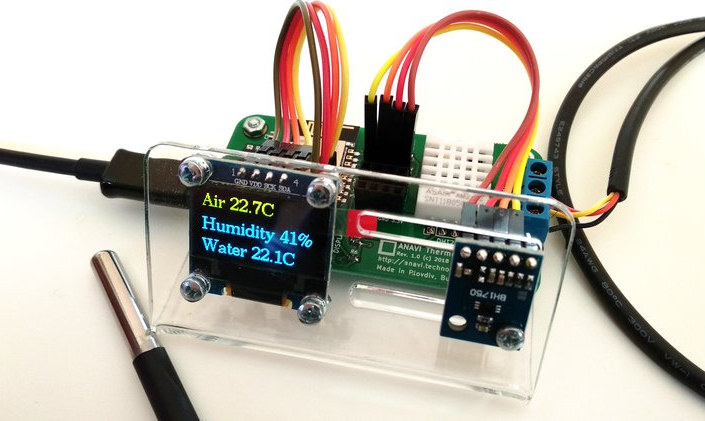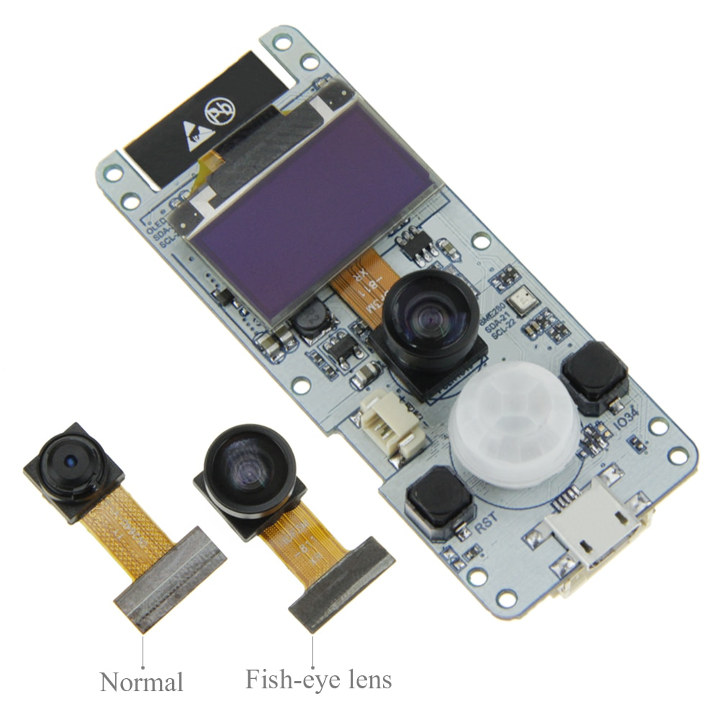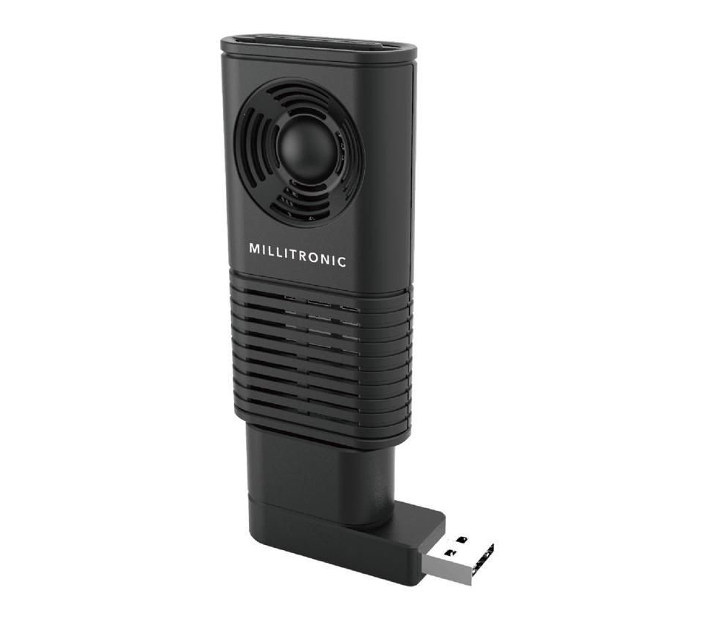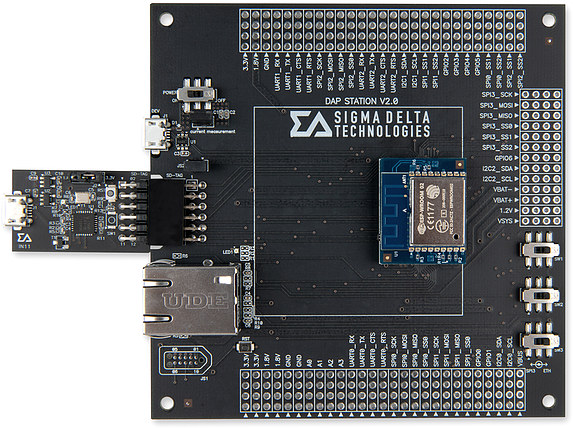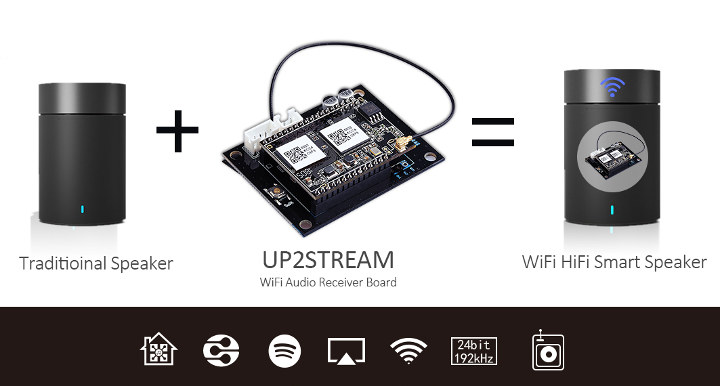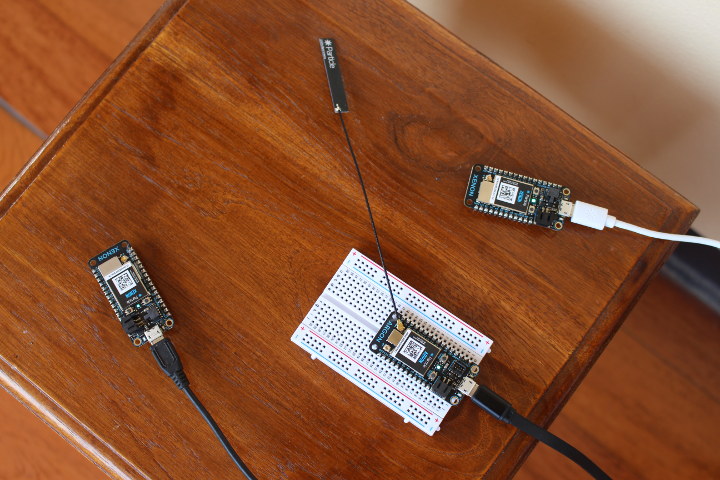ANAVI Technology launched several open source hardware boards for the Raspberry Pi and ESP8266 maker communities in the past, starting with RabbitMax Flex home automation HAT for Raspberry Pi, and several others including ANAVI Light Controller ESP8266 board to control LED strips. All boards are designed with KiCad opensource EDA software, and I’ve tested several already such as ANAVI Infrared pHAT or ANAVI Light Controller, and found documentation to be very good and easy to follow. The company has now launched another ESP8266 board with ANAVI Thermometer that allows you to monitor temperature and humidity, effectively acting as a thermostat for home automation. ANAVI Thermometer specifications: SoC – Espressif Systems ESP8266 Tensilica L106 32-bit processor Connectivity – WiFi 802.11 b/g/n Display – Mini OLED display Build-in sensor – AM2302 (DHT22) temperature and humidity sensor Expansion Terminal block for DS18B20 waterproof temperature sensor UART pins 3x slots for I2C sensors Misc – […]
TTGO T-Camera ESP32 Camera Board Comes with OLED Display, Sensors
ESP32 is now being used for AI workloads such as face detection with camera boards like ESP32-CAM, or the upcoming ESP-EYE board from Espressif Systems themselves, combined with ESP-WHO face detection and recognition framework. The two aforementioned board require you to use a phone to vizualize the results, unless you blink some LEDs or connect your own display. But the just released TTGO T-Camera board includes a 128×64 OLED display which should allow you to display face detection and/or recognition results, as well as a BME280 environmental sensor, a PIR sensor, and an optional fisheye lens. TTGO T-Camera board specifications: ESP32-WROVER-B Wireless Module SoC – ESP32 dual core Tensilica LX6 processor Memory – 8MB PSRAM Storage – 4MB SPI flash Connectivity – 2.4 GHz 802.11n WiFi 4, Bluetooth 4.2 LE Camera – 2MP OV2640 camera with normal or fisheye lens Display – 0.96″ 128×64 OLED display connected via SSD1306 I2C […]
Year 2018 in Review, Top 10 Posts, and Some Stats
That’s it, we’ve already reached the last day of 2018, and it’s time to have a look back at what happened during the past year. On the mini PC front, Gemini Lake based mini PCs took over from Apollo Lake with some performance improvements, but I expected the price point to be a bit lower than it is today. Apart from further developments with regards to mobile processors, it feels 2018 was an off-year for processors, such as the ones found in TV boxes and development boards, with mostly more of the same. Allwinner and Rockchip did not release any really interesting processor, and Amlogic only launched S905X2 and S905Y2 which are mostly evolutions of their previous generation with an OpenGL 3.x capable GPU and USB 3.0. Rockchip RK3399 stood out this year, as despite being launched in 2016, it suddenly became popular again with many RK3399 SBCs coming to […]
Millitronic MG360 is a WiGig 802.11ad USB Adapter
802.11ad was announced in 2016 as a new WiFi standard supporting 60 GHz frequency and up to 7 Gbps throughput, but it has recently been superseded by the backward compatible but further improved 802.11ay allowing up to 100 Gbps bandwidth, and 300 to 500 meters range in theory. The new standard is supported by Qualcomm QCA64x8 and QCA64x1 WiFi chipsets that can handle up to 10 Gbps, and found in Snapdragon 855 mobile processor. If you want your network to benefit from 802.11ad WiFi – 802.11ay is not quite available yet – , you’ll first new a compatible router such as NETGEAR Nighthawk X10 AD7200 router, and end nodes supporting 802.11ad WiFi as well as. But most device on the market don’t, and in theory you should be able to add 802.11ad WiFi to any device with a USB 3.0 port, but it turns out there aren’t that many 802.11ad […]
SDTxArm Pelion Kit is a Modular IoT Devkit Designed for Arm Mbed Cloud Platform
South Korea based Sigma Delta Technologies’ SDTxArm Pelion Kit is a modular development kit comprised of a baseboard, as well as CPU and interface modules that is specifically designed to work with Arm Pelion cloud based device management service and Mbed OS for wearables and IoT applications. DAP (Debug Access Port) Station Ver.2 baseboard key features and specifications: USB – 1x micro USB 2.0 port Expansion I/Os via rows of through-holes 3x UART Interfaces 4x SPI Interfaces 3x I²C Interfaces 7x GPIO 4x analog inputs Debugging / Programming 1x TC2050 tag connection designed to allow programming without purchasing additional Interface if the user already has an appropriate Interface Module from other companies. I assume this is related to Tag Connect TC2050-IDC. 1x SD-TAG with JTAG/SWD signals Power Supply – 5V via micro USB port The DAP station takes an SDT Board (i.e. CPU board), as well as an interface board […]
Up2Stream WiFi Audio Receiver Module Targets DIY Wireless Speakers
If you own a set of very good speakers, and are interested in making them smarter, Arylic Up2Stream WiFi audio receiver module may be a solution to look into. The module allows to make your own DIY wireless speakers by adding WiFi connectivity, and features such as multiroom, AirPlay, DLNA streaming, Spotify, and Internet radio streaming. Up2Stream (WA31) hardware specifications: SoC – MediaTek MT7688AN MIPS processor @ up to 580 MHz System Memory – 64MB DDR2 Storage – 16MB flash Connectivity – 2.4GHz 802.11 b/g/n 1T1R WiFi up to 150 Mbps with 5 dBi I-PEX antenna Audio – 24-bit / 192 KHz decoding, 20 Hz – 20KHz frequency range, 4-pin speaker connector with 2.0mm pitch USB – 1x USB 2.0 port port Power Supply – 5VDC / 1A via 2-pin header (2.0mm pitch) Power Consumption – 160 to 320 mA Dimensions – 55.21 x 41.37mm The module ships with a […]
Particle Mesh Networking Review – Part 2: Getting Started Guide with Argon & Xenon
I’ve recently received a Particle Mesh IoT Development Kit with one Argon WiFi + Mesh (802.15.4) board acting as gateway, three Xenon Mesh boards, and various sensors and accessories. I’ve already showcased the hardware in the first part in the review, so in this post I’ll post my experience getting started with Particle Mesh networking using the kit. Beside the kit, you’ll need a few micro USB cables, a mobile phone running Android or iOS, a reliable Internet connection (more on that later), and a host PC for programming and debugging potential issues. Setting Up Particle Argon & Xenon boards First we’ll need to configure / setup the boards. Go to https://setup.particle.io to login or create an account if you don’t already have one, and you should be brought the following page. Select Mesh, and you’ll be asked to setup a gateway first. Any of the boards from Particle Mesh […]
PyGo Wearable Devices Create LoRa Mesh Networks (Crowdfunding)
Pycom has made some interesting IoT boards running MicroPython in the past starting with WiFi capable WiPy in 2015, and followed by various others supporting various wireless standard including Bluetooth, LoRa, Sigfox, and NB-IoT with LoPy and Fipy. The company launched all their boards via crowdfunding campaigns, and they are now back on Kickstarter for their PyGo plug-n-play wearable devices creating PyMesh networks with up to 12km range between nodes, and managed using Pylife mobile app. Typical use cases include basic connectivity (e.g. messaging) in remote areas without cellular access, and assets / pets / kids location tracking, There are two version of PyGo: PyGo1 with mesh networking only, and PyGo2 that adds cellular network access. Pygo hardware specifications: SoC – Espressif Systems ESP32 dual core WiFi 4 + BLE SoC System Memory – 64 Mbit (8MB) RAM Storage – 8MB flash Display – 128×36 OLED display Connectivity PyMesh up […]


